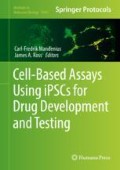Abstract
Multielectrode arrays enable the detection of spontaneous cellular network activity, which can be utilized for the characterization of a neuronal culture. Here, we describe the detection of spontaneous neuronal activity in iPSC-derived cortical neurons using a 24-well plate for a multiwall-MEA system.
Access this chapter
Tax calculation will be finalised at checkout
Purchases are for personal use only
References
Luhmann HJ, Sinning A, Yang JW et al (2016) Spontaneous neuronal activity in developing neocortical networks: from single cells to large-scale interactions. Front Neural Circuits 10:40
Marom S, Shahaf G (2002) Development, learning and memory in large random networks of cortical neurons: lessons beyond anatomy. Q Rev Biophys 35(1):63–87
van Pelt J, Vajda I, Wolters PS et al (2005) Dynamics and plasticity in developing neuronal networks in vitro. Prog Brain Res 147:173–188
Amin H, Maccione A, Marinaro F et al (2016) Electrical responses and spontaneous activity of human iPS-derived neuronal networks characterized for 3-month culture with 4096-electrode arrays. Front Neurosci 10:121
Gross GW, Harsch A, Rhoades BK et al (1997) Odor, drug and toxin analysis with neuronal networks in vitro: extracellular array recording of network responses. Biosens Bioelectron 12(5):373–393
Braak H, Del Trecidi K (2015) Neuroanatomy and pathology of sporadic Alzheimer’s disease. Adv Anat Embryol Cell Biol 215:1–162
Holtkamp M, Buchheim K, Elsner M et al (2011) Status epilepticus induces increasing neuronal excitability and hypersynchrony as revealed by optical imaging. Neurobiol Dis 43(1):220–227
Uhlhaas PJ, Singer W (2010) Abnormal neural oscillations and synchrony in schizophrenia. Nat Rev Neurosci 11(2):100–113
Shi Y, Kirwan P, Smith J et al (2012) Human cerebral cortex development from pluripotent stem cells to functional excitatory synapses. Nat Neurosci 15(3):477–486. S1
Du X, Parent JM (2015) Using patient-derived induced pluripotent stem cells to model and treat epilepsies. Curr Neurol Neurosci Rep 15(10):71
MacLaren EJ, Charlesworth P, Coba MP et al (2011) Knockdown of mental disorder susceptibility genes disrupts neuronal network physiology in vitro. Mol Cell Neurosci 47(2):93–99
Shi Y, Kirwan P, Livesey FJ (2012) Directed differentiation of human pluripotent stem cells to cerebral cortex neurons and neural networks. Nat Protoc 7(10):1836–1846
Author information
Authors and Affiliations
Corresponding author
Editor information
Editors and Affiliations
Rights and permissions
Copyright information
© 2019 Springer Science+Business Media, LLC, part of Springer Nature
About this protocol
Cite this protocol
Kizner, V., Fischer, S., Naujock, M. (2019). Multielectrode Array (MEA)-Based Detection of Spontaneous Network Activity in Human iPSC-Derived Cortical Neurons. In: Mandenius, CF., Ross, J. (eds) Cell-Based Assays Using iPSCs for Drug Development and Testing. Methods in Molecular Biology, vol 1994. Humana, New York, NY. https://doi.org/10.1007/978-1-4939-9477-9_19
Download citation
DOI: https://doi.org/10.1007/978-1-4939-9477-9_19
Published:
Publisher Name: Humana, New York, NY
Print ISBN: 978-1-4939-9476-2
Online ISBN: 978-1-4939-9477-9
eBook Packages: Springer Protocols

